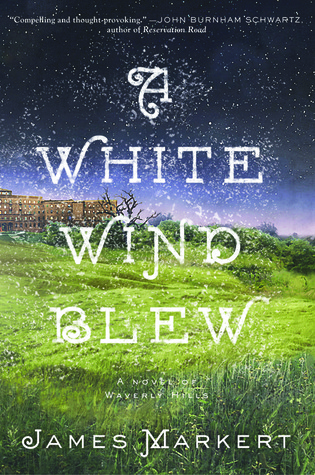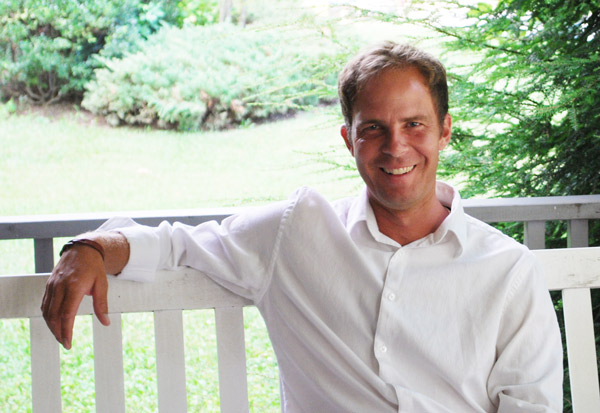A White Wind Blew
March 14, 2013 11:04 AM
 Author James Markert’s debut novel, A White Wind Blew (Sourcebooks, Incorporated), describes a dedicated physician battling the 1920s Tuberculosis epidemic without today’s antibiotics. Dr. Wolfgang Pike’s passion for music drives him to play his violin and create a patient orchestra to battle TB, the irrepressible enemy. Markert grew up in Louisville, Kentucky, and was intrigued by the Waverly Hills Sanatorium, a tuberculosis hospital with the highest rate of TB in the country. Markert’s sister-in-law, Jenny Branson, MT-BC, is also an AMTA member. For more information from James, please see the following Questions and Answers originally printed in The Huffington Post and stay tuned for additional information about this interesting new novel.
Author James Markert’s debut novel, A White Wind Blew (Sourcebooks, Incorporated), describes a dedicated physician battling the 1920s Tuberculosis epidemic without today’s antibiotics. Dr. Wolfgang Pike’s passion for music drives him to play his violin and create a patient orchestra to battle TB, the irrepressible enemy. Markert grew up in Louisville, Kentucky, and was intrigued by the Waverly Hills Sanatorium, a tuberculosis hospital with the highest rate of TB in the country. Markert’s sister-in-law, Jenny Branson, MT-BC, is also an AMTA member. For more information from James, please see the following Questions and Answers originally printed in The Huffington Post and stay tuned for additional information about this interesting new novel.
A White Wind Blew
Ronna Kaplan, MA, Immediate Past President, American Music Therapy Association
 Author James Markert grew up in Louisville, Kentucky, and was intrigued by the Waverly Hills Sanatorium, a tuberculosis hospital with the highest rate of TB in the country, at a very young age. His debut novel, A White Wind Blew (Sourcebooks, Incorporated), is set in Waverly Hills, that massive Gothic structure that is said to be one of the most haunted places on earth. The book, Markert's first novel, went on sale last week.
Author James Markert grew up in Louisville, Kentucky, and was intrigued by the Waverly Hills Sanatorium, a tuberculosis hospital with the highest rate of TB in the country, at a very young age. His debut novel, A White Wind Blew (Sourcebooks, Incorporated), is set in Waverly Hills, that massive Gothic structure that is said to be one of the most haunted places on earth. The book, Markert's first novel, went on sale last week.
Authors Jodi Picoult and Allison Pearson recently wrote about present day music therapists in their very successful novels, Sing You Home (Atria Books) and I Think I Love You (Alfred A. Knopf), respectively. But why did James Markert choose to develop his main character as a forerunner of a modern day music therapist? Markert shared his answers to this and other questions with our colleagues at the American Music Therapy Association.
What led you to have the main character be a forerunner of a modern day music therapist?
JM: During that time of Prohibition and Post World War I, there was no cure for tuberculosis. Patients were dying at Waverly Hills Tuberculosis Sanatorium at an alarmingly high rate, so if I couldn't give them a medical cure, I wanted to give them hope. As it says inside the book jacket, "When the body fails, you've got two choices. Send the doctor in, or send a prayer up." But when no miracle arrives, I leaned on music. I don't know of anyone who doesn't like music. It lifts spirits. It boosts morale. It calms and relaxes. This was the part I wanted my main character, Wolfgang Pike, to play. He plays music for the patients--a nurse secretly hands him daily request lists. The head doctor believes his "musical medicine" is a waste of time, but Wolfgang plows on. More musicians arrive. An orchestra and choir are formed and beautiful music soon flows over the wooded hillside, completely changing the culture of healing at Waverly.
What is it that intrigued you about music and encouraged you to prominently feature it in your book?
JM: I love music. Any kind of music. I have to listen to it in the car when I drive, or when I go running, and I always listen to it when I write. My sister is a pianist and I grew up listening to her play. For hours. And hours. And ...anyway, the classical music seeped in and harvested there. I'm more of a rock-n-roll fan but the classical music was always soothing for me. In high school I went to the movies to see Amadeus, and the music in it really moved me. It still remains one of my favorite movies of all time. Music can be so cinematic. I'm also a produced screenwriter, and I've always wanted to create something historical with music as the theme. Amadeus was a major influence in writing A White Wind Blew, as well as Shawshank Redemption. As far as tone and scope, I was going for a combination of the two, with a lofty goal that A White Wind Blew could be for someone what Amadeus was for me.
What did you learn that perhaps surprised you as you explored the field of music therapy in the late 1920's?
JM: Music has been used as a tool for healing for thousands of years, although not as sophisticated and detailed as what music therapists are now trained to do for their patients. In my novel and out of desperation, my main character, Wolfgang Pike, picks up his violin inside a tent at Camp Taylor, where many of the wounded from World War I have returned to convalesce, and he plays for a soldier who is suffering. The soldier immediately calms, and then another soldier calls Pike over to play for him. I was fascinated to learn that part of modern music therapy started with war veterans. Musicians in the communities visited veterans' hospitals to play for those suffering from war trauma. And because of this, some hospitals around the country began to hire musicians.
What kinds of research and experiences did you explore to familiarize yourself with music therapy?
JM: My sister-in-law, Jenny Branson, is a music therapist, so speaking with her about it before I started writing was a big help. I also read some articles, journals, and researched on line. I intentionally didn't mirror some of the most modern music therapy techniques and philosophies because my story takes place before professional music therapy really started. I wanted Wolfgang to be pretty raw with his playing. He took requests from patients and he played, and sometimes he would make up his own songs. In a sense, I didn't want to know too much about modern music therapy because Wolfgang was learning to stumble through it on his own, so I think it made it more true to his character.
Can you clarify the difference between music therapy now and back in the 1920's?
JM: I think the biggest difference was in the detail and specialization. Perhaps back in the 1920's (and I may be simplifying it here) it was more of just playing music for the patient, while now, therapists are professionally trained. They specifically design their music therapy sessions to an individual's needs, with ages ranging from infants to the elderly. And now music therapists work in hospitals, drug and alcohol clinics, nursing homes, hospice programs, halfway houses, schools, prisons, and the list goes on. Hopefully this is a profession that will continue to grow, and if my novel can help bring focus to it in any way I'm honored.
What role does music play in your life? In what way, if any, has that changed since writing this book?
JM: I have to have music. I collect CD's. I love listening to live music of any kind and going to big concerts with my wife. I've never played an instrument but I grew up in a very music-oriented family. If my sister wasn't practicing in the living room, our CD player was constantly running with my brothers' music and my dad's music--Pink Floyd, The Who, Yes, U2, Pearl Jam... My kids listen to my music. They're 8 and 4, but they sing the songs in the car right along with me. Writing A White Wind Blew has given me more of an appreciation for classical music. There's so much history there, and I had a fun time researching it.
How did you decide what music to include in this book?
JM: I knew that I wanted Mozart in the book. Beyond that, I leaned heavily on my uncle, who was Head of the Music Department at Baylor University for many years. He helped make the decisions on what musical pieces would go the best at certain parts of the book, as well as what pieces would work best with the instruments available in the book--namely the piano, violin, and flute.
What do you think your readers should know about the profession of music therapy?
JM: That it's a real profession, and a very important one. And that it takes a special talent to be able to play the music AND have that bedside manner required to connect with patients. My sister-in-law Jenny is a music therapist and she's great at what she does.
What message would you like to give to music therapists?
JM: Thank you. Keep doing what you do. We've all heard the phrase--turn that frown upside down. Well, it's not always that easy, but with music it certainly can be. And as Shakespeare once said: "If music be the food of love; play on."
Thank you, Mr. Markert, for helping spread the word about music therapy. It is gratifying to see and hear more and more instances of music therapy given its due in the media! For more detailed information about music therapy as a profession, go to www.musictherapy.org. And to learn about the certification process for music therapists, go to www.cbmt.org. Also feel free to check out more columns on music therapy in The Huffington Post.
Back
8455 Colesville Road, Suite 1000 | Silver Spring MD 20910 | Phone: 301.589.3300 | Fax: 301.589.5175